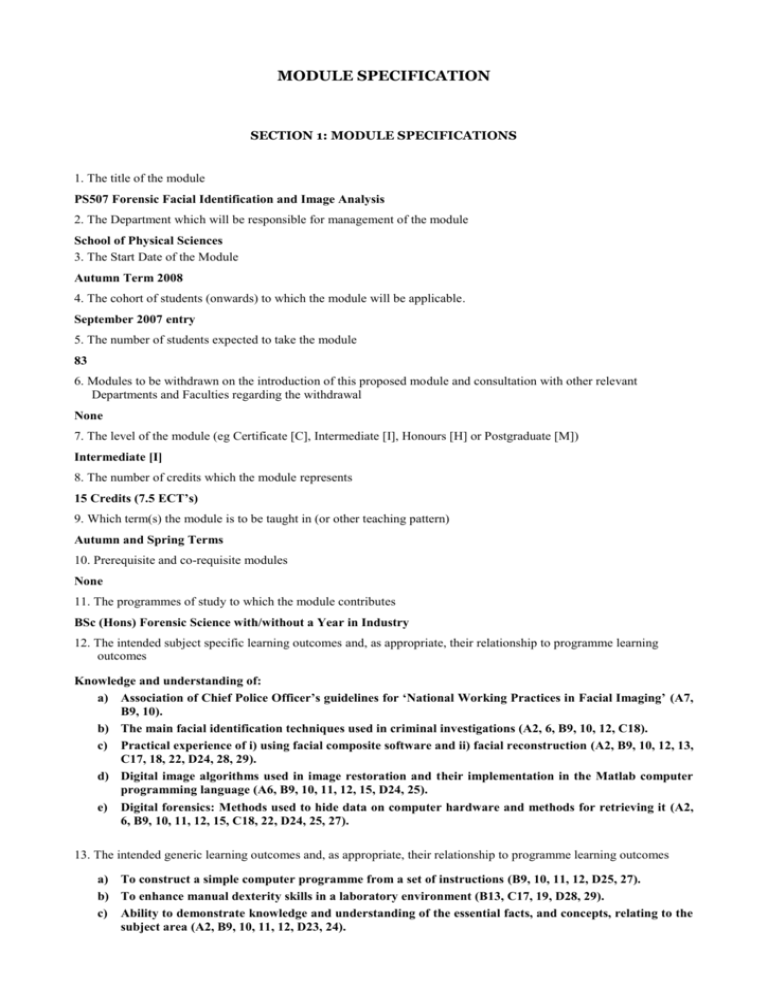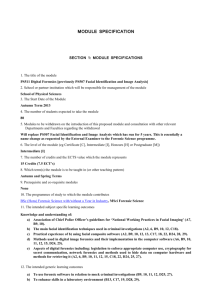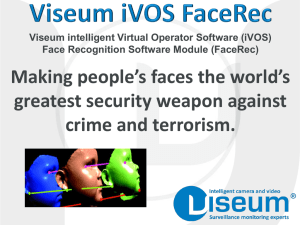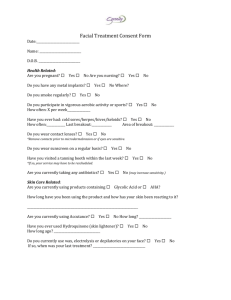
MODULE SPECIFICATION
SECTION 1: MODULE SPECIFICATIONS
1. The title of the module
PS507 Forensic Facial Identification and Image Analysis
2. The Department which will be responsible for management of the module
School of Physical Sciences
3. The Start Date of the Module
Autumn Term 2008
4. The cohort of students (onwards) to which the module will be applicable.
September 2007 entry
5. The number of students expected to take the module
83
6. Modules to be withdrawn on the introduction of this proposed module and consultation with other relevant
Departments and Faculties regarding the withdrawal
None
7. The level of the module (eg Certificate [C], Intermediate [I], Honours [H] or Postgraduate [M])
Intermediate [I]
8. The number of credits which the module represents
15 Credits (7.5 ECT’s)
9. Which term(s) the module is to be taught in (or other teaching pattern)
Autumn and Spring Terms
10. Prerequisite and co-requisite modules
None
11. The programmes of study to which the module contributes
BSc (Hons) Forensic Science with/without a Year in Industry
12. The intended subject specific learning outcomes and, as appropriate, their relationship to programme learning
outcomes
Knowledge and understanding of:
a) Association of Chief Police Officer’s guidelines for ‘National Working Practices in Facial Imaging’ (A7,
B9, 10).
b) The main facial identification techniques used in criminal investigations (A2, 6, B9, 10, 12, C18).
c) Practical experience of i) using facial composite software and ii) facial reconstruction (A2, B9, 10, 12, 13,
C17, 18, 22, D24, 28, 29).
d) Digital image algorithms used in image restoration and their implementation in the Matlab computer
programming language (A6, B9, 10, 11, 12, 15, D24, 25).
e) Digital forensics: Methods used to hide data on computer hardware and methods for retrieving it (A2,
6, B9, 10, 11, 12, 15, C18, 22, D24, 25, 27).
13. The intended generic learning outcomes and, as appropriate, their relationship to programme learning outcomes
a) To construct a simple computer programme from a set of instructions (B9, 10, 11, 12, D25, 27).
b) To enhance manual dexterity skills in a laboratory environment (B13, C17, 19, D28, 29).
c) Ability to demonstrate knowledge and understanding of the essential facts, and concepts, relating to the
subject area (A2, B9, 10, 11, 12, D23, 24).
14. A synopsis of the curriculum
Facial Identification [10 lectures + 5 console sessions + 1 laboratory + 2 workshops]
Facial reconstruction, facial composites, description by witness – cognitive interview - Turnbull’s rules (R v
Turnbull, 1976), identity parades – psychology of facial identification – video identity parades, facial mapping,
automated recognition technologies, age progression.
Digital Image Analysis [6 lectures and+ 6 console sessions]
Image formation, image storage, image distortion, image restoration methods, the digital image in crime
detection, steganography (implementation and detection).
Digital Forensics [ 4 lectures + 1 console session]
Encryption, fallacies about hiding and destroying data, where to find data and methods for retrieving it, disk
imaging, file integrity, cryptographic hashing, privacy vs need for investigation.
15. Indicative Reading List
Crime Scene to Court, The Essentials of Forensic Science, 2 nd edition, ed. P. White. Royal Society of Chemistry,
2004. ISBN: 0854046569.
Digital Image Processing using Matlab, Gonzalez, Woods and Eddins, Pearson Prentice Hall, 2004.
Handbook of Computer Crime Investigation, E. Casey, Academic Press, 2002.
16. Learning and Teaching Methods, including the nature and number of contact hours and the total study hours which
will be expected of students, and how these relate to achievement of the intended learning outcomes
Contact hours comprising: 20 Lectures (learning outcomes: 12a, 13c), 4 three hour + 9 one hour Computing
Console Sessions (learning outcomes: 12b, c, d, e, 13a), 1 three hour Laboratory Class and 2 two hour
Workshops (Learning outcomes: 12b, c, 13b). Private study (102 hours) including time to complete assignments
17. Assessment methods and how these relate to testing achievement of the intended learning outcomes
Assessment is by examination (60%) and continual assessment (40%). The subject specific learning outcomes
(a-e) and generic learning outcome (c) will be determined by examination and by assignments as appropriate.
Generic learning outcome (b) will be monitored by laboratory demonstrators/supervisors. Generic learning
outcome (a) will be monitored in computer console sessions and assessed by continuous assessment assignments.
18. Implications for learning resources, including staff, library, IT and space
Library resources: Digital Image Processing using Matlab (11 copies held), Crime Scene to Court (7
copies held), Handbook of Computer Crime Investigation (0 copies – optional reading material)
4 three hour + 9 one hour Computer console sessions
The majority of the teaching will be provided by University of Kent staff. Contributions will also be
made from experts/practitioners within the field of facial identification and digital forensics.
19. A statement confirming that, as far as can be reasonably anticipated, the curriculum, learning and teaching methods
and forms of assessment do not present any non-justifiable disadvantage to students with disabilities
All teaching provision will conform with the University of Kent equal opportunities statements, with no
disadvantage anticipated.
If the module is part of a programme in an Associate College, please complete the following:
20. Associate College:
21. University Department (for cognate programmes) or Faculty (for non-cognate programmes) responsible for the
programme:
SECTION 2: MODULE IS PART OF A PROGRAMME OF STUDY IN A UNIVERSITY
DEPARTMENT
Statement by the Director of Learning and Teaching: "I confirm I have been consulted on the above
module proposal and have given advice on the correct procedures and required content of module proposals"
................................................................
Director of Learning and Teaching
..............................................
Date
…………………………………………………
Print Name
Statement by the Head of Department: "I confirm that the Department has approved the introduction
of the module and, where the module is proposed by Departmental staff, will be responsible for its
resourcing"
.................................................................
Head of Department
…………………………………………………….
Print Name
..............................................
Date










